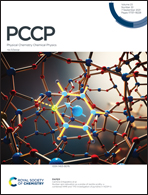Diazaphospholenes as reducing agents: a thermodynamic and electrochemical DFT study†
Abstract
Diazaphospholenes have emerged as a promising class of metal-free hydride donors and have been implemented as molecular catalysts in several reduction reactions. Recent studies have also verified their radical reactivity as hydrogen atom donors. Experimental quantification of the hydricities and electrochemical properties of this unique class of hydrides has been limited by their sensitivity towards oxidation in open air and moist environments. Here, we implement quantum chemical density functional theory calculations to analyze the electrochemical catalytic cycle of diazaphospholenes in acetonitrile. We report computed hydricities, reduction potentials, pKa values, and bond dissociation free energies (BDFEs) for 64 P-based hydridic catalysts generated by functionalizing 8 main structures with 8 different electron donating/withdrawing groups. Our results demonstrate that a wide range of hydricities (29–66 kcal mol−1) and BDFEs (58–81 kcal mol−1) are attainable by functionalizing diazaphospholenes. Compared to the more common carbon-based hydrides, diazaphospholenes are predicted to require less negative reduction potentials to electrochemically regenerate hydrides with an equivalent hydridic strength, indicating their higher energy efficiency in the tradeoff between thermodynamic ability and reduction potential. We show that the tradeoff between the reducing ability and the energetic cost of regeneration can be optimized by varying the BDFE and the reorganization energy associated with hydride transfer (λHT), where lower BDFE and λHT correspond to more efficient catalysts. Aromatic phosphorus hydrides with predicted BDFEs of ∼62 kcal mol−1 and λHT's of ∼20 kcal mol−1 are found to require less negative reduction potentials than dihydropyridines and benzimidazoles with predicted BDFEs of ∼68 and ∼84 kcal mol−1 and λHT's of ∼40 and ∼50 kcal mol−1, respectively.

- This article is part of the themed collection: 2021 PCCP HOT Articles


 Please wait while we load your content...
Please wait while we load your content...